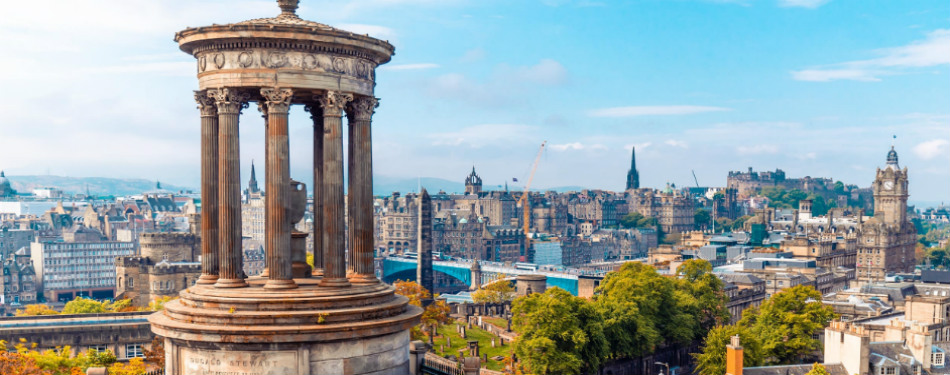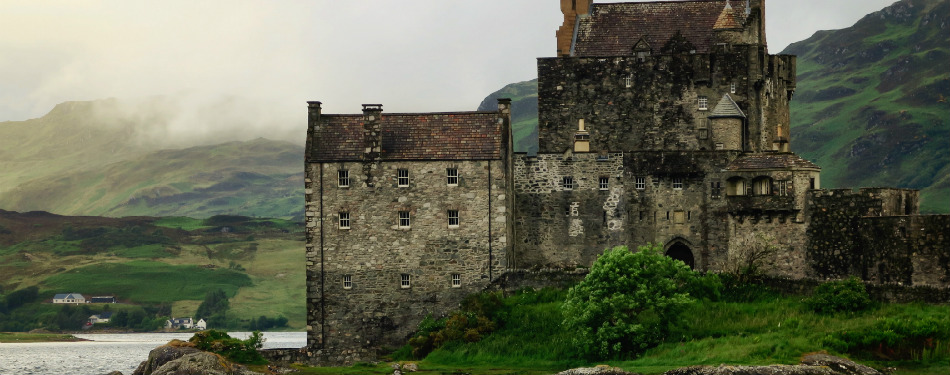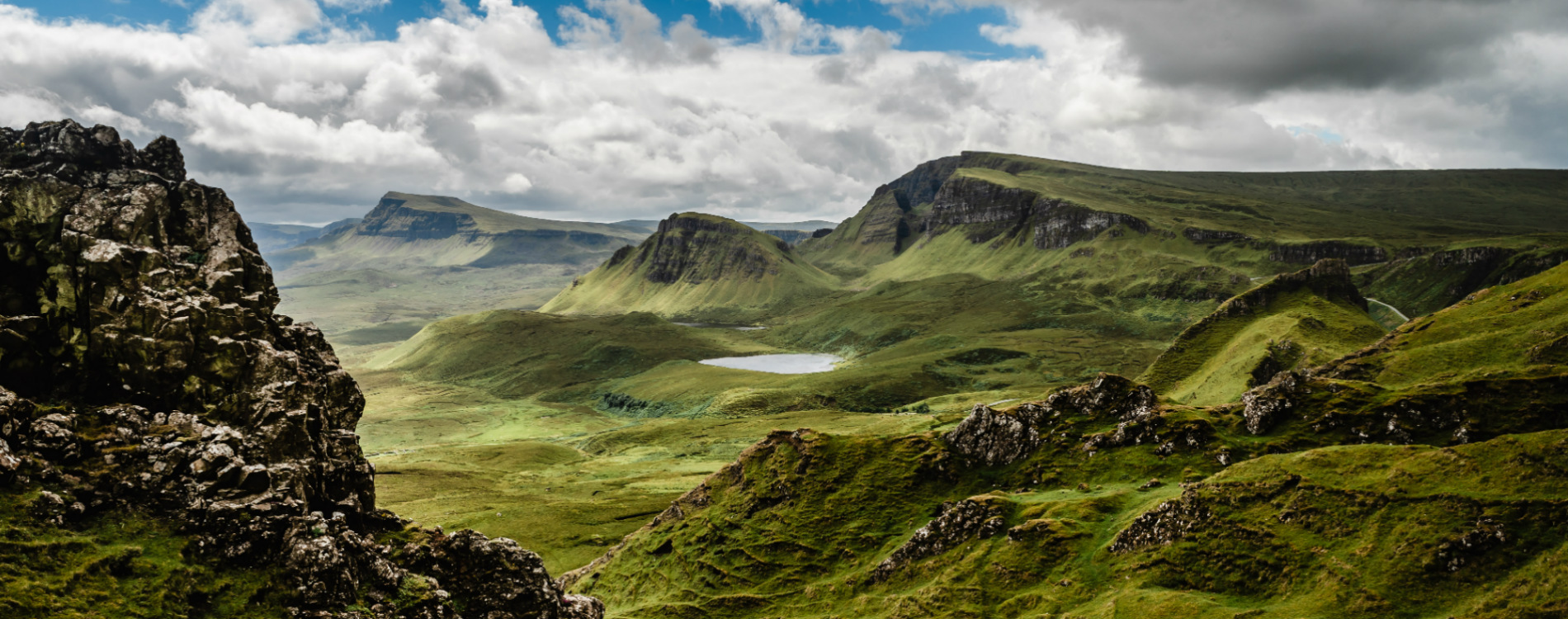A Tumultuous History and Unmatched Scenery
Scotland conjures up images of sheepherders with walking sticks and sheepdogs, highlanders in kilts, golfers in plaid knickers, wailing bagpipes and tales of the Loch Ness Monster. One thinks of Scotland’s great solitude, with its small historic towns, remote stretches of heather moors, secluded beaches, stark mountains and long, deep glens and lochs. The colorful, tumultuous history of preserved castles and battlefields, the sordid lives of illustrious kings and queens, long fighting clans and the scathing works of national literary heroes add to the country’s mystique. Our team of experts can help you experience Scotland in style – from personal drivers and expert tour guides to luxury hotels.
The first step is to explore Edinburgh, Scotland’s second largest city, cultural center and capital since the 15th century. The city is home to the National Museum of Scotland, the National Library of Scotland and the Scottish National Gallery. It is the annual venue of the General Assembly of the Church of Scotland. The University of Edinburgh was founded in 1582 and is ranked 20th in the QS World University Ranking. The city is also famous for the Edinburgh International Festival and the Fringe, the latter being the world’s largest annual international arts festival.

Still, Edinburgh’s most famous landmark is Edinburgh Castle, the fortress walls up on a hill having dominated the city’s skyline since the 13th century. Highlights include the Scottish Crown Jewels, the infamous Stone of Destiny (used in the coronation of monarchs) and St. Margaret’s Chapel, the oldest building in Edinburgh. Entrance to the castle is via a drawbridge to a broad esplanade, where the famous Edinburgh Military Tattoo is held every August. Below, the Royal Mile stretches down the steep escarpment to the elegant Palace of Holyroodhouse, official residence of the British monarch in Scotland since the 16th century. Lined by historic landmarks, the Royal Mile is filled with small shops, kiltmakers and tearooms. Between its tall brick buildings is a charming network of narrow alleys, called ‘winds’ that you will have great fun exploring.
Our next stop, idyllic Loch Lomond, just a short drive northwest of Glasgow, is Britain’s largest lake and, according to Scottish writer Walter Scott (Ivanhoe, Rob Roy), ‘The Queen of Scottish Lakes.’ With plentiful trout and salmon, it is the loch for anglers, and it has plenty of open space for hikers.
The largest and northernmost of Scotland’s Inner Hebrides archipelago, the Isle of Skye is especially popular with nature lovers. The Isle of Skye is marked by wild, mountain scenery with green valleys, caves, lonely glens, sandy beaches and rushing waterfalls — quite remarkable variety for an island just 80 kilometers (50 miles) long and never more than 24 kilometers (15 miles) wide. The Isle also features an abundance of wildlife that includes otters, seals and 200 species of birds. Among the many other Inner Hebrides islands, Iona is probably the most notable and controversial, as St. Columba came from Ireland in the 6th century to spread Catholicism. It holds Scotland’s oldest Christian cemetery with graves of 60 Scottish kings, including Macbeth.
Culturally and physically similar to the Hebrides, the lovely Isle of Arran is separated from them by the Kintyre Peninsula. Often called ‘Scotland in Miniature,’ it mirrors the landscapes of the entire country in an area of scarcely 429 square kilometers (166 square miles), with rolling moors, rugged mountains, sandy beaches, fishing harbors and, of course, castles.

Loch Ness – we all probably picture the mythical monster from legend – is, at 37 kilometers (23 miles) long, the largest body of water in Scotland’s Great Glen. It is part of a waterway of four lochs connecting the east and west coasts. Each loch is surrounded by some beautiful highland scenery, and can be viewed on a day cruise, but no place is more scenic than Loch Ness itself with the romantic ruins of Urquhart Castle on its hillside.
Further north, the Scottish Highlands has a mystique born of its rugged, untamed landscapes, its long history and stories of violence and romance. Sparsely inhabited, these mountains and rocky shores are loved by hikers, bikers and by those who enjoy fishing, golf, sea kayaking, white-water rafting and other outdoor adventures in Britain’s largest National Park. Sprinkled through it are lovely little villages. Stopping in the tiny coastal village of Dornoch (another of our favorites) to see its beach, cathedral, castle ruins, three local whiskey distilleries and famous golf links, and in John o’Groats (the lowercase ‘o’ is not a typo), overlooking the Pentland Firth where a much-photographed sign proclaims it the northernmost point of Britain, is just fun.
No trip to Scotland can ignore its most enduring invention, the game of golf, which has been very much a part of Scottish life for more than three centuries. The Old Course at St. Andrews, opened in 1754, is considered the longest standing golf course in the world. It sits uniquely in the town’s center so that pedestrians can critique tee shots on the first hole. St. Andrews is the most recognized golf course in the world and is a constant in the rotation of British Open courses. We have arranged for many, many of our travelers to play the Old Course as part of a trip.
We should all wear kilts and knickers at some point in our lives!

